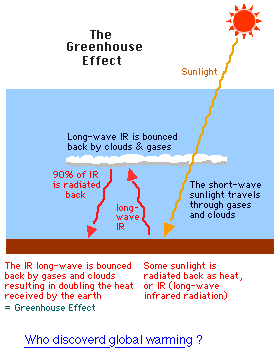|
The term 'Greenhouse Effect' refers to the way certain gases
trap heat in the atmosphere, much as the glass in a greenhouse
prevents rising warm air from escaping.
Enhancement of this effect by human activity - not the effect itself, which is entirely natural - has experts worried. In fact, Earth, 93 million miles from its energy source - the sun - would be about 32° C colder if certain atmospheric gases did not trap heat. We probably owe existence of life on this planet to the greenhouse effect.
Whether radiation is absorbed depends on the size & type of objects through which it travels. About half of sunlight hitting the outer atmosphere reaches the surface, where it transfers energy to land and water. The surface then sheds that energy as heat, largely infrared radiation ( IR ). If the air contained nothing but its main components almost all of the energy emitted at the surface would radiate uninterrupted back into space.
But in fact, nearly 90 % of that long-wave-length radiation is caught by clouds
and gases, which sends much of it down again. The astonishing result is
that Earth's surface is hit daily with twice That is because some kinds of molecules, known collectively as 'greenhouse' gases, are just the right size and configuration to trap long-wavelength IR and re-radiate it. Most greenhouse gases elude natural chemical cleaning processes in the atmosphere, and many stay aloft from decades to centuries. However, the term 'global warming' is deceptive because it suggests that the paramount issue is average temperature. But much more important is a change in the way water moves around. As Earth's surface warms, most of the energy goes into evaporating water. When rising water vapor condenses again, it sheds that energy as heat into the air. Even a modest amount of global warming would cause a substantial increase in air moisture because for every 1 degree Celsius that its temperature rises, the atmosphere can hold 6 percent more water vapor. That means a substantial warming would produce more clouds and rain on average and more violent precipitation in some areas and severe drying of soils in many other locations. A greater cloud cover would explain why warming seems to have increased most at nighttime and in winter. During the day, clouds keep the land cooler by shading the surface, while at night they form a barrier that confines heat close to the surface.
Excerpted from 'Climate Change Primer' |
